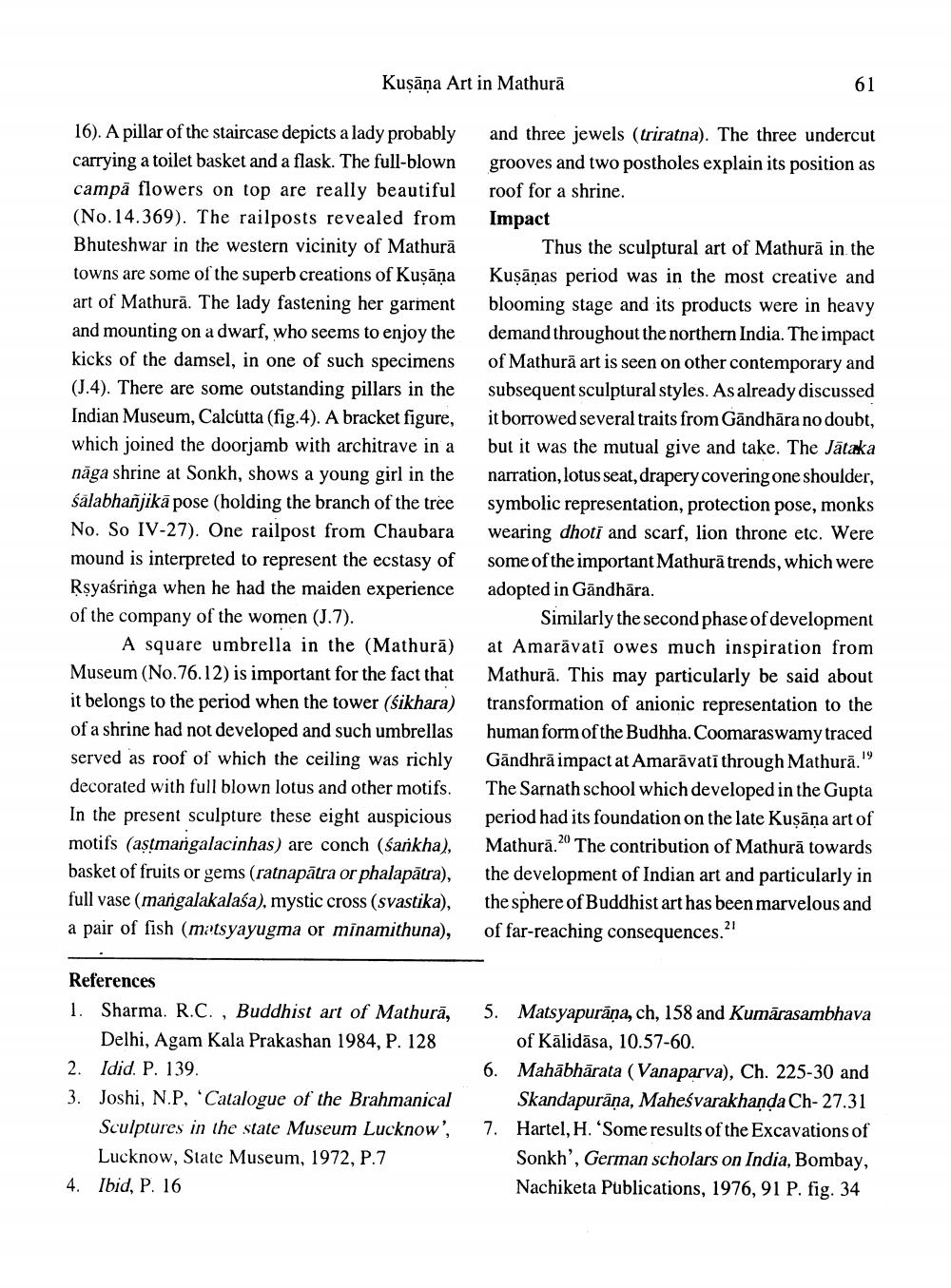________________
Kuşāņa Art in Mathurā
61
16). A pillar of the staircase depicts a lady probably carrying a toilet basket and a flask. The full-blown campā flowers on top are really beautiful (No.14.369). The railposts revealed from Bhuteshwar in the western vicinity of Mathurā towns are some of the superb creations of Kuşāņa art of Mathurā. The lady fastening her garment and mounting on a dwarf, who seems to enjoy the kicks of the damsel, in one of such specimens (1.4). There are some outstanding pillars in the Indian Museum, Calcutta (fig.4). A bracket figure, which joined the doorjamb with architrave in a nāga shrine at Sonkh, shows a young girl in the śālabhañjikā pose (holding the branch of the tree No. So IV-27). One railpost from Chaubara mound is interpreted to represent the ecstasy of Rsyasringa when he had the maiden experience of the company of the women (5.7).
A square umbrella in the (Mathurā) Museum (No.76.12) is important for the fact that it belongs to the period when the tower (śikhara) of a shrine had not developed and such umbrellas served as roof of which the ceiling was richly decorated with full blown lotus and other motifs. In the present sculpture these eight auspicious motifs (astmargalacinhas) are conch (sarkha), basket of fruits or gems (ratnapätra or phalapātra), full vase (mangalakalasa), mystic cross (svastika), a pair of fish (matsyayugma or minamithuna),
and three jewels (triratna). The three undercut grooves and two postholes explain its position as roof for a shrine. Impact
Thus the sculptural art of Mathurā in the Kuşāņas period was in the most creative and blooming stage and its products were in heavy demand throughout the northern India. The impact of Mathurā art is seen on other contemporary and subsequent sculptural styles. As already discussed it borrowed several traits from Gāndhāra no doubt, but it was the mutual give and take. The Jātaka narration, lotus seat, drapery covering one shoulder, symbolic representation, protection pose, monks wearing dhoti and scarf, lion throne etc. Were some of the important Mathurā trends, which were adopted in Gāndhāra.
Similarly the second phase of development at Amaravati owes much inspiration from Mathurā. This may particularly be said about transformation of anionic representation to the human form of the Budhha. Coomaraswamy traced Gāndhrā impact at Amaravatī through Mathurā." The Sarnath school which developed in the Gupta period had its foundation on the late Kuşāņa art of Mathurā.20 The contribution of Mathurā towards the development of Indian art and particularly in the sphere of Buddhist art has been marvelous and of far-reaching consequences.'
References 1. Sharma. R.C. , Buddhist art of Mathurā,
Delhi, Agam Kala Prakashan 1984, P. 128 2. Idid. P. 139. 3. Joshi, N.P, 'Catalogue of the Brahmanical
Sculptures in the state Museum Lucknow',
Lucknow, State Museum, 1972, P.7 4. Ibid, P. 16
5. Matsyapurāņa, ch, 158 and Kumārasambhava
of Kālidāsa, 10.57-60. 6. Mahābhārata (Vanaparva), Ch. 225-30 and
Skandapurāņa, Maheśvarakhanda Ch-27.31 7. Hartel, H. 'Some results of the Excavations of
Sonkh', German scholars on India, Bombay, Nachiketa Publications, 1976, 91 P. fig. 34




